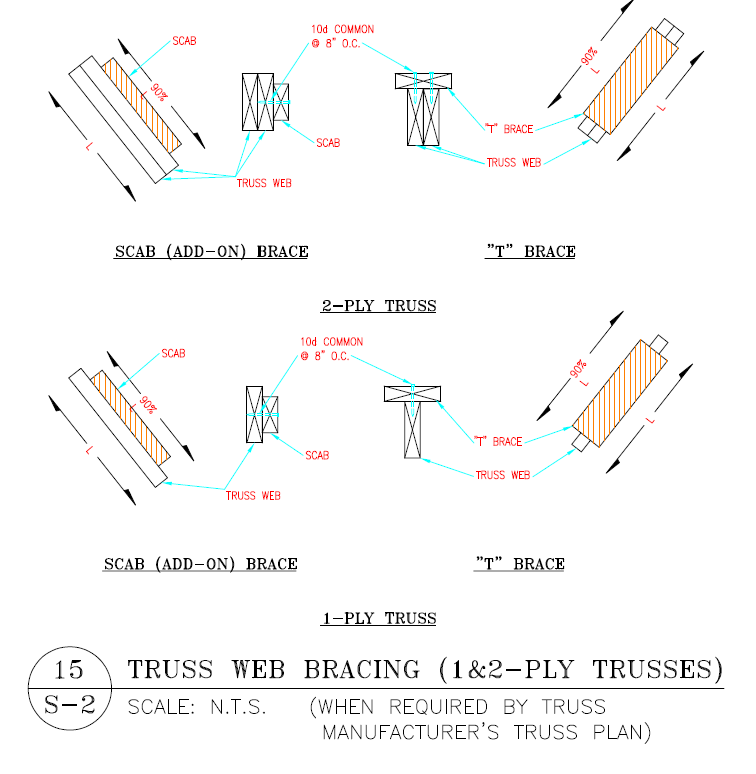How Truss Bracing Code Change Could Harm You
Originally Published by: SBCA Magazine — April 12, 2022
SBCA appreciates your input; please email us if you have any comments or corrections to this article.
There was a lot of interest and communications this past week regarding the two IRC code change proposals (RB245-22 & RB246-22) recently considered at the ICC Code Action Hearings (CAH) in Rochester, New York. We believe this attention is warranted based on the impact these proposals would have on the component industry, as well as the questions they raise regarding who should have domain over truss bracing.
If you haven’t read them yet, we encourage everyone read through the proposals: RB245-22 & RB246-22. If you have additional perspective to share, please don’t hesitate to contact us (advocacy@sbcacomponents.com)
We have spent considerable time reviewing the proposal language and have consulted with several structural engineers, bracing experts, component manufacturers (CMs), framers, code officials, and other stakeholders to formulate some comprehensive analysis.
As written, the proposals appear to achieve four objectives:
- Change IRC required information on Truss Design Drawings (TDD);
- Remove a direct IRC reference to BCSI and reroute it through the TPI-1 design standard;
- Introduce shall language requiring fully sheathed truss top chords with wood structural panels and sheathed truss bottom chords with gypsum board; and,
- Address permanent continuous lateral restraints and associated bracing methodology.
Each of these proposed changes are substantial, and significantly alters the IRC with respect to CM operations.
Harm: Problematic Prescriptive Bracing v. Engineered Bracing Design
The most concerning, and arguably the most sweeping change is point three above, which is contained in the proposal below in yellow:
R802.10.3 Bracing. Trusses shall be braced to prevent rotation and provide lateral stability in accordance with the requirements specified in the construction documents for the building and on the individual truss design drawings. In the absence of specific bracing requirements, trusses shall be braced in accordance with accepted industry practice such as the SBCA Building Component Safety Information (BCSI) Guide to Good Practice for Handling, Installing & Bracing of Metal Plate Connected Wood Trusses. All trusses shall be installed with a fully sheathed top chord (roof or floor) with wood structural panels, and a fully sheathed bottom chord (ceiling) with gypsum board ceilings. Any trusses installed without fully sheathed top and bottom chords shall require a project specific bracing design prepared by any registered design professional. Permanent individual truss member restraint where shown on the truss design drawings shall be accomplished by one of the following methods:
By using the word “shall,” this language requires ALL roof trusses in IRC projects to have their top chords sheathed with wood structural panels. Alone, this isn’t radical and reflects what happens in the field for most roof truss applications.
However, the continuation of that sentence requires a fully sheathed bottom chord with “gypsum board ceilings.” This should grab everyone’s attention, but because it is sandwiched between a lot of other language, it is easy to overlook it in a casual read. Many roof trusses have gypsum applied to form a ceiling, so it may appear congruous with the requirement for structural wood panel sheathing on the top chord. But what about the other truss systems that do not typically have gypsum applied? For example, how would these conditions be handled?
- Unfinished garages
- Large sheds
- Valley trusses
- Piggy-back trusses
- Cantilevered trusses
The language highlighted pink above introduces additional “shall” language, should the previous requirement not be met: “Any trusses installed without fully sheathed top and bottom chords shall require a project-specific bracing design prepared by any registered design professional.”
So, any application where the bottom chord is not sheathed with gypsum, a project-specific bracing design is required. This eliminates the ability for standard details to be used. It also eliminates the ability to use prescriptive guides such as BCSI. Similarly, it doesn’t allow for tract builders to reuse the same bracing design on the same plan on multiple projects. This is very restrictive language to introduce into the prescriptive bracing requirements within the IRC.
The proposed language also states the project-specific bracing design must be prepared by a registered design professional. A registered design professional is defined in the code as an individual who is registered or licensed to practice engineering or architecture as defined by an individual state.

Connecting the dots, anywhere trusses are used in an IRC application, and gypsum is not fully applied to the bottom chord, an engineer is required to provide a project specific bracing plan. Why is this change necessary? Who stands to benefit from a code change proposal like this? How would this impact the cost of a project? How much time would this add to the roof truss design and review process?
This is just one way in which CMs would be harmed through the adoption of RB245-22 & RB246-22. SBCA will continue to offer analysis regarding these code change proposals to educate the marketplace and keep CMs abreast of code changes that impact their industry.






